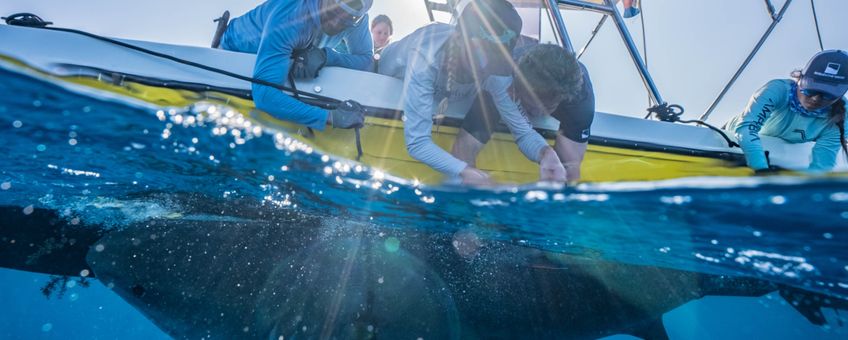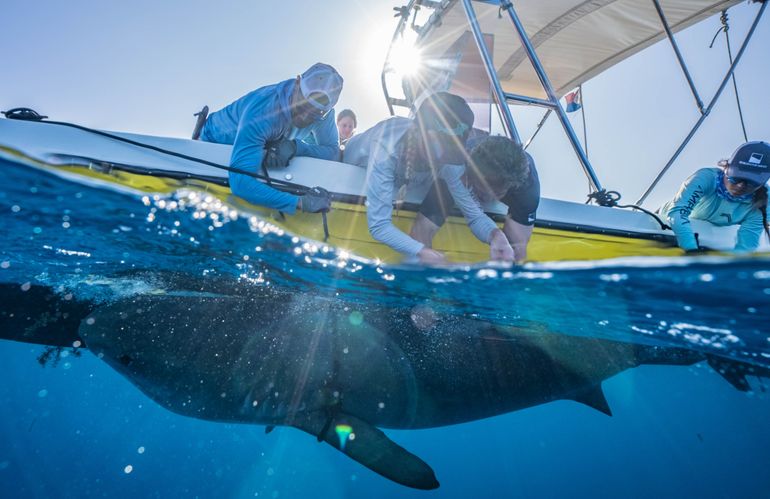
Groundbreaking shark research conducted in waters around Sint Maarten
Beneath the Waves, Dutch Caribbean Nature Alliance (DCNA), Nature Foundation St Maarten, Saba Conservation Foundation (SCF), World Wide Fund for Nature – NetherlandsMembers from the Nature Foundation St. Maarten (NFSXM), the Dutch Caribbean Nature Alliance (DCNA), the Saba Conservation Foundation (SCF), and Beneath the Waves participated in the 'Shark Shakedown' project. The research expedition was a part of a wider research project into tiger sharks in the region, funded by the World Wide Fund for Nature (WWF-NL) through the Biodiversity Funds and the Dutch National Postcode Lottery.
The expedition lasted five days. Three species of sharks were tagged: tiger sharks (Galeocerdo cuvier), Caribbean reef sharks (Carcharhinus perezi), and nurse sharks (Ginglymostoma cirratum), all ranging from sub-adults to adults.

Participants received hands-on training with experts from Beneath the Waves to prepare them for the expedition to the Saba Bank in August 2021. The goal of this upcoming expedition is to determine whether the Saba Bank is a breeding area for tiger sharks in the Eastern Caribbean. The high-definition ultrasound technology the team used was created by E. I. Medical Imaging and pioneered by collaborator Dr. James Sulikowski, of Arizona State University. This technology has successfully been used to identify maturity state and the stage of pregnancy in various shark species. This is a first for shark science in the region.
The scientists successfully confirmed an early pregnancy stage in a large female tiger shark. They also placed a satellite tag on the shark during the workup process. Using satellite tracking over the next few months, the scientists hope to confirm evidence of Sint Maarten being a breeding location for these globally threatened animals. In another 'shark tagging first’, Beneath the Waves’ Chief Scientist, Dr. Austin Gallagher, placed the first camera tag on a tiger shark in the Dutch Caribbean. The team successfully recovered the camera package during the expedition, and the animal has already shown promising results regarding shark behavior in the region.
Using a camera tag on a female tiger shark (Source: DCNA Communication)
Both the satellite tag and camera tag have shown that these tiger sharks prefer to travel in the area between Sint Maarten and Saint Barths; however, these are only the first detections. No assumptions can be made yet regarding the movement of these animals.
The information gained from this research will provide a better understanding of the importance of both the status of sharks in Sint Maarten’s territorial waters and in the Yarari Sanctuary. It will also provide information about the role these ecosystems play in the life-cycle of tiger sharks in the wider Caribbean region. Tiger sharks are currently categorized as Near-Threatened by the International Union for Conservation of Nature, while Caribbean reef sharks have very recently been upgraded to Endangered. Sharks play key roles in maintaining the balance within local and regional marine ecosystems and maintaining biodiversity. Their prorection is therefore crucial.
Follow the Dutch Caribbean Nature Alliance on Facebook, Instagram (dcnanature) or DCNA’s website to learn more about the shark expedition and other nature news from the Dutch Caribbean.
*Disclaimer* Though we are still in the midst of a pandemic, the partners of this project have strived to ensure all participants were safe to work amongst each other and to continue the important work of nature conservation in the Dutch Caribbean.
For more information please contact the Dutch Caribbean Nature Alliance by email or phone +599.717.5010.
Text: Dutch Caribbean Nature Alliance
Photo: Sami Kattan, Beneath the Waves
Movie: DCNA Communication
